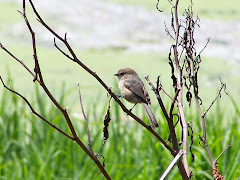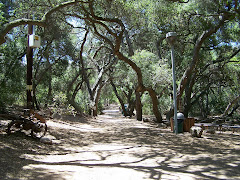
At the Los Angeles Arboretum in Arcadia.
 At the Los Angeles Arboretum in Arcadia.
At the Los Angeles Arboretum in Arcadia.You can see the thin, white plume in the above picture. The plume extends from the back of its head down to the shoulders. This BCNH is stretching its neck out normally as it looks for fish and other prey in the water. I also took this picture at the Los Angeles Arboretum. The bird didn't seem to care much that people were coming and going all around it. BCNHs can be pretty bold in areas where people often are. I noticed the same at Lake Balboa in the San Fernando Valley. This totally focused bird (pictured above) watched for fish constantly, but did not catch one in the fifteen minutes I was there. Notice the red eyes. It is one of the smaller herons. It has a chunky build and often hunkers down so much that its neck totally disappears. Birds who have completed the transformation to adult plumage are at least three years old. According to Cornell's All About Birds, this is the most widely distributed heron, appearing on 5 continents.
 Up a tree during the day. Resting. No neck visible. Huntington Central Park East.
Up a tree during the day. Resting. No neck visible. Huntington Central Park East.
Immature Black-Crowned Night Heron at Huntington Central Park near the library.
This is an immature BCNH--we see remnants of the juvenile plumage, but a darkening of the wings and cap like the adult. I took the above picture at Huntington Central Park East on the far side of Talbert Lake opposite the fenced in garden. It is an area where herons of all kinds like to roost when the lake is full. This picture was taken in the late morning when the BCNH had all retired to the trees to sleep.
 Juvenile Black-crowned Night Heron -- courtesy of US Dept of Fish and Wildlife
Juvenile Black-crowned Night Heron -- courtesy of US Dept of Fish and Wildlife(Added for comparison.)
I used to work in a building overlooking the Golden Shore Marine Biological Reserve Park in Long Beach. As I went on my daily walk, I would skirt the section with the white sidewalk underneath the trees that edged the parking lot. I would look up as I walked around the white stains, and there would be a BCNH always around the same place. (Seal Beach had a serious problem with BCNHs roosting in their trees. See article in OC Register.) BCNH were frequently active on the nearby piers at Golden Shore early in the morning usually until 7AM or 8AM or on rare occasions 9AM.

At the LA Arboretum--in the late afternoon about 4:00PM in the middle of summer.
But BCNH do come out to search for food in daylight when they need it. In most cases though, the early bird not only gets the worm, but the early birder also gets a look at the BCNH.
 Black-crowned Night Heron at Bolsa Chica about 4pm.
Black-crowned Night Heron at Bolsa Chica about 4pm.You usually have to be an early birder to get good look at the Black-crowned Night Heron. So get ready to go birding early in the OC, and look for the Black-crowned Night Heron. You just might find the little black-and-white heron going for one last fish.
 Immature Black-crowned Night Heron at El Dorado Nature Center in Long Beach, California
Immature Black-crowned Night Heron at El Dorado Nature Center in Long Beach, CaliforniaUnusual video of BCNH named "Charlie" by the locals who feed him chicken and other foods. He eats from their hands and just hangs out with the people there.
 Black-crowned Night Heron taking advantage of the fish at the San Diego Wild Animal Park in the late afternoon.
Black-crowned Night Heron taking advantage of the fish at the San Diego Wild Animal Park in the late afternoon.OC Birder Girl Links
Green Heron--Butorides virescens
Great Blue Heron--Ardea herodias
Great Egret--Ardea alba
Reddish Egret--A Rare Bird
Snowy Egret--Egretta thula
 Black-crowned Night Heron hunkered down in the pickleweed early in the morning at Bolsa Chica.
Black-crowned Night Heron hunkered down in the pickleweed early in the morning at Bolsa Chica.External Links and Resources
USGS Page on Black-Crowned Night Herons
Pictures of mature and immatures. Short discussion on differentiating bitterns and immature Black-Crowned Night Herons.
All About Birds--Black-Crowned Night Heron
Detailed article on BCNH. Lots of information.
Smithsonian National Zoo page on Black-Crowned Night Herons
Very detailed page.
Honolulu Zoo's page on Black-crowned Night Herons
Lots of good information.
Oiseaux.net's page on Black-crowned Night Herons
The English Page of a French Birding site. Lots of good pictures.
Audubon Society Waterbirds: Black-crowned Night Heron
Distribution details.
BIOLOGICAL AND ECOTOXICOLOGICAL CHARACTERISTICS --Black-Crowned Night Heron
More technical site but interesting. Information from the USGS.
Nature Works--Black-crowned Night Heron
Interesting facts and pictures.
 Hunting from the pickleweed early in the morning near the footbridge at Bolsa Chica. Notice his reflection in the water.
Hunting from the pickleweed early in the morning near the footbridge at Bolsa Chica. Notice his reflection in the water.Videos
The Internet Bird Collection: Black-Crowned Night Heron Videos
Good videos of BCNH both immatures and adults. For a great video of an juvenile, see this video by Pere Sugranyes from Barcelona, Spain on the IBC.
 Black-crowned Night Heron foraging at Bolsa Chica Ecological Preserve near the foot bridge.
Black-crowned Night Heron foraging at Bolsa Chica Ecological Preserve near the foot bridge.Home - Index - Contact - Shop
Subscribe to My Birding Blog: Posts (Atom)

 Male Rose-breasted Grosbeak feeding nestlings. Courtesy of the US Department of Fish and Wildlife.
Male Rose-breasted Grosbeak feeding nestlings. Courtesy of the US Department of Fish and Wildlife.






 A mature
A mature  A view of the wetlands
A view of the wetlands 



















 Ready to make a mad dash across the water at
Ready to make a mad dash across the water at  Strutting at
Strutting at 

 Reddish Egret and a
Reddish Egret and a 







